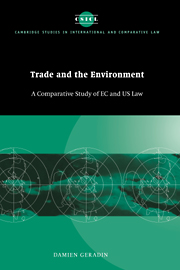Book contents
- Frontmatter
- Contents
- Preface
- Table of cases
- Table of legislation
- List of abbreviations
- Introduction
- PART 1 NEGATIVE HARMONIZATION
- 1 The case law of the Court of Justice
- 2 The case law of the Supreme Court
- 3 Comparative analysis
- 4 Judicial and legislative intervention
- PART 2 POSITIVE HARMONIZATION
- Conclusion
- Bibliography
- Index
- CAMBRIDGE STUDIES IN INTERNATIONAL AND COMPARATIVE LAW
2 - The case law of the Supreme Court
Published online by Cambridge University Press: 29 September 2009
- Frontmatter
- Contents
- Preface
- Table of cases
- Table of legislation
- List of abbreviations
- Introduction
- PART 1 NEGATIVE HARMONIZATION
- 1 The case law of the Court of Justice
- 2 The case law of the Supreme Court
- 3 Comparative analysis
- 4 Judicial and legislative intervention
- PART 2 POSITIVE HARMONIZATION
- Conclusion
- Bibliography
- Index
- CAMBRIDGE STUDIES IN INTERNATIONAL AND COMPARATIVE LAW
Summary
The principle of free trade
The textual source of the Supreme Court's authority to review the constitutionality of state measures interfering with trade is to be found in Article I, section 8 of the Constitution (the ‘Commerce Clause’), which in its relevant part reads: ‘The Congress shall have the power … to regulate commerce with foreign Nations, and among the several states.’ On its face, the Commerce Clause appears to be a grant of authority to Congress to regulate commerce rather than a limitation on state activity when Congress has not acted. However, acknowledging the framers' intention to create a common market and to avoid economic balkanization of the Union, the Supreme Court has long recognized that the Commerce Clause also contains a ‘dormant’ dimension that operates as a prohibition on interferences with commerce by the states. ‘The very purpose of the Commerce Clause,’ the court has written, ‘was to create an area of free trade among the several states’. Yet, the objective of ensuring free interstate trade has not been construed as an absolute prohibition on state measures interfering with commerce. In this context, an important task for the court has been to develop devices for distinguishing between permissible and impermissible state interferences with commerce.
Since its first recognition of a dormant dimension in the Commerce Clause more than one and a half centuries ago, the Supreme Court has experimented with a variety of formulations for the Commerce Clause limitation upon the states.
- Type
- Chapter
- Information
- Trade and the EnvironmentA Comparative Study of EC and US Law, pp. 34 - 52Publisher: Cambridge University PressPrint publication year: 1997



